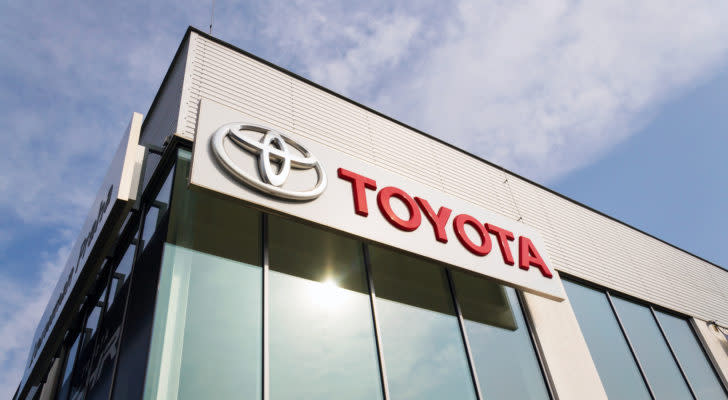February’s Smart Buys: 7 Value Stocks You Can’t Afford to Miss
Investors are back to looking at value stocks as many see high-flying growth as a bubble poised to burst. Even index investors focused on benchmarks like the S&P 500 are increasingly wary of the risks associated with a handful of stocks carrying the rest.
That’s why value stocks represent a dual benefit: they help diversify away tech and growth risk, and, as the name implies, many are on-sale value buys since they’ve gone overlooked for so long.
Of course, value traps abound when looking at value stocks. That’s why running down the details and validating that a company has a long-term and viable future is key when researching value stocks. These seven meet the mark, though, and could be the top value stocks to invest in this year.
InvestorPlace - Stock Market News, Stock Advice & Trading Tips
McDonald’s (MCD)

Source: Retail Photographer / Shutterstock.com
McDonald’s (NYSE:MCD) reported its first quarterly sales miss in four years this week, but that doesn’t mean the value stock is down for the count.
In fact, McDonald’s stock is rising rapidly after a quick downturn post-earnings.
The most bullish outlook on McDonald’s centers on the company’s rapid adaptation to emerging tech and trends. From an operational standpoint, McDonald’s digital and delivery services are rapidly gaining ground on dine-in or drive-through, marking 40% of recent sales.
This shows that McDonald’s is willing and able to adapt to shifting consumer purchasing trends as online ordering and delivery accelerate post-pandemic.
The company also knows how to listen to customers, as recent marketing efforts saw the Hamburgular return, Grimace milkshakes take social media by storm, and adult Happy Meals drop. All these initiatives mean that, far from resting on its laurels, McDonald’s is happy to innovate and try new things in an attempt to drive sales, retain customers, and target a new era of fast food enjoyers.
Caterpillar (CAT)

Source: Shutterstock
Caterpillar’s (NYSE:CAT) recent earnings report marked massive increases in revenue and profit alike, sending shares to record highs this week. But the run isn’t over for this value stock.
In the earnings call, CEO Jim Umpleby summed up the year’s wins in a single sentence: “I’m very proud of our global team’s strong performance as they achieved the best year in our 98-year history, including record full-year sales and revenues, record adjusted profit per share and record [industrial] free cash flow.”
CAT’s annual revenue climbed 13% compared to 2022, with earnings per share peaking nearly 50% higher than the preceding year. CAT recognized that their higher financing rates led to increased top-line numbers, showing the company’s ability to adapt to the new rate regime.
Still, despite financial engineering, CAT also saw direct-to-user sales spike even as dealer sales stagnated. This points to an emerging trend wherein users want to cut out the middleman, driven by advances in tech that turn your home office into a virtual showroom.
As residential and commercial construction rates climb, expect big things from this value stock.
Toyota Motor Corp (TM)

Source: josefkubes / Shutterstock.com
Mostly overlooked as electric vehicles and labor disputes captured media attention, value stock Toyota Motor Corp (NYSE:TM) is on a winning streak competitors wish they could match.
The company continues dominating the sweet spot between gas- and battery-powered vehicles with its popular hybrid lines, which Toyota attributed its recent success to in its earnings report.
Analysts agree, as Goldman Sachs wrote, “We think the market is now rethinking the potential of hybrid products, which are a strength of Toyota.”
But Toyota is still hedging a bet on an EV-centric future, making it a value stock for the long haul. Toyota is dropping a whopping $1.3 billion on expanding its Kentucky plant to include capacity for a new all-electric SUV. Though demand is falling across the EV sector, innovation is bringing the tech’s price down, which bodes well for the family and soccer mom segment the SUV will likely target.
Medtronic (MDT)

Source: JHVEPhoto / Shutterstock.com
Medtronic (NYSE:MDT), a blue-chip healthcare stock and premier medical device manufacturer, is a top pick for value investors who want to capture healthcare’s long-term upside.
Although the stock stayed flat in 2023, it’s surging today and returned over 6% since January. But the company’s future outlook overshadows its current modest showing, offering an enticing opportunity for investors to enter.
Medtronic’s latest earnings report showcases a robust growth trajectory post-pandemic, setting it apart from many other healthcare stocks with a staggering 112% year-over-year increase in GAAP earnings.
Medtronic’s growth largely benefits from its venture into integrating artificial intelligence in healthcare. The collaboration with Nvidia (initiated in early 2023) aims to create AI-driven platform solutions, which they expect to be widely adopted by 2024.
This advancement holds promise for investors who have stood by during the stock’s recent static phase, but it isn’t too late to jump into this hot value stock.
H&R Block (HRB)

Source: Ken Wolter / Shutterstock.com
As tax season looms, H&R Block (NYSE:HRB) stands out among value stocks based on its fintech innovation, a rare trait among mature firms typically shying away from new and emergent tech.
Last year, the company navigated challenges amid speculations about the IRS launching a free national tax filing service.
HRB has made an impressive recovery and now strategically positions itself to lead the tax return sector and seize new revenue opportunities.
HRB launched a mobile banking service last year to counterbalance the tax industry’s seasonal nature. By April, this service had garnered significant customer engagement, with 291,000 users signed up and total deposits exceeding $280 million.
HRB’s small-business accounting service achieved a 10% year-over-year growth. These strategic initiatives show HRB’s commitment to stabilizing cash flow and securing a consistent revenue stream throughout the year, a notable challenge for tax-centric firms.
HRB’s total yield currently sits at 10.4%, shockingly high for any stock but particularly noteworthy compared to other value stocks. That high yield comes from a measly 34% payout ratio, too, indicating HRB has plenty of cash to grow while keeping shareholders happy.
AT&T (T)

Source: Lester Balajadia / Shutterstock.com
AT&T (NYSE:T) stands out as a top growth-oriented value stock, actively broadening its scope to target an interconnected world.
Specifically, the company is backing space startup AST SpaceMobile’s (NASDAQ:ASTS) venture into satellite-based cell service, which is on track for a commercial launch in 2024. This initiative is just one of the driving forces behind AT&T’s rise in 2024.
The company released its Q4 earnings report at the end of January, and despite earnings falling below expectations, the report highlighted strong growth areas.
Notably, AT&T’s wireless service revenue saw a near 4% year-over-year increase, signaling the company’s adept management of economic pressures to maintain high subscriber numbers and implement necessary price adjustments.
This success is clear from the company’s postpaid phone net additions, which outperformed expectations: AT&T reported 526,000 new plan subscriptions, surpassing the forecasted 487,500. This achievement is striking in a market that is already quite saturated.
Though some (incorrectly) call it a yield trap, AT&T’s current dividend distribution rate is 6.3%, representing a 56% payout ratio.
U-Haul (UHAL)

Source: Sundry Photography / Shutterstock.com
U-Haul (NYSE:UHAL) is the name in DIY moving and truck rental, with competitors like Penske Truck Leasing and Budget Rental unable to match even a fraction of the company’s 23,000 locations and 200,000 rental truck fleet.
Notably, investors overlook the company as, in the words of Barron’s writer Andrew Bary, “There is virtually no Wall Street coverage of U-Haul. It is run like a private company by the Shoen family, which owns about half the company.”
UHAL trades at a slim 16x earnings and 1.8x book value. If interest rate hopes hold true and the Fed brings its target down, expect substantial residential housing outcomes.
That means more people moving, which, of course, benefits U-Haul’s bottom line as more elect to go the DIY route. Only 22% of movers elected to have a company do the work for them, while 37.5% went the rental truck route. Household budgets remain tight so, even if rates fall and residential moves accelerate, we can expect the DIY ethos to reign supreme.
On the date of publication, Jeremy Flint held no positions in the securities mentioned. The opinions expressed in this article are those of the writer, subject to the InvestorPlace.com Publishing Guidelines.
Jeremy Flint, an MBA graduate and skilled finance writer, excels in content strategy for wealth managers and investment funds. Passionate about simplifying complex market concepts, he focuses on fixed-income investing, alternative investments, economic analysis, and the oil, gas, and utilities sectors. Jeremy’s work can also be found at www.jeremyflint.work.
More From InvestorPlace
The #1 AI Investment Might Be This Company You’ve Never Heard Of
Musk’s “Project Omega” May Be Set to Mint New Millionaires. Here’s How to Get In.
The post February’s Smart Buys: 7 Value Stocks You Can’t Afford to Miss appeared first on InvestorPlace.
